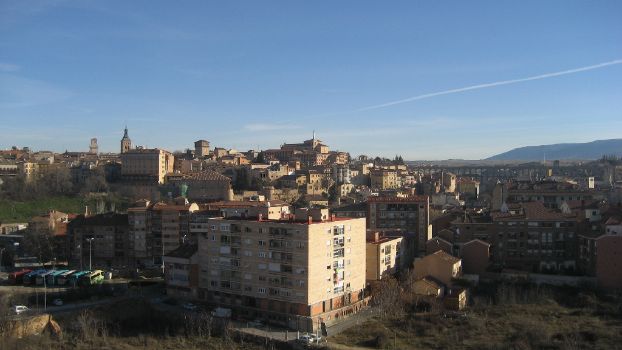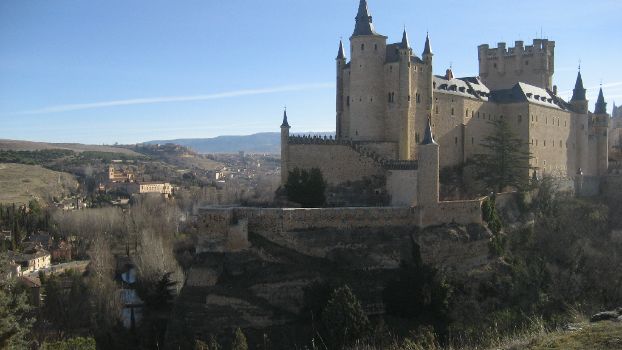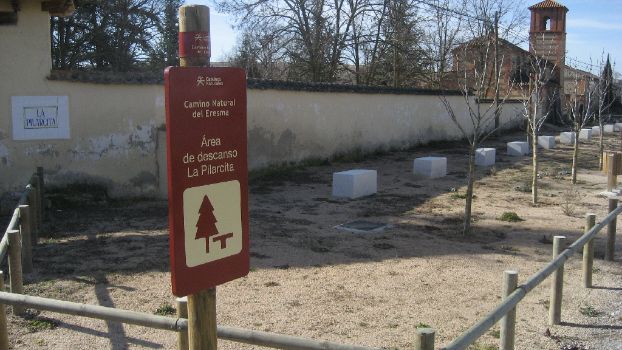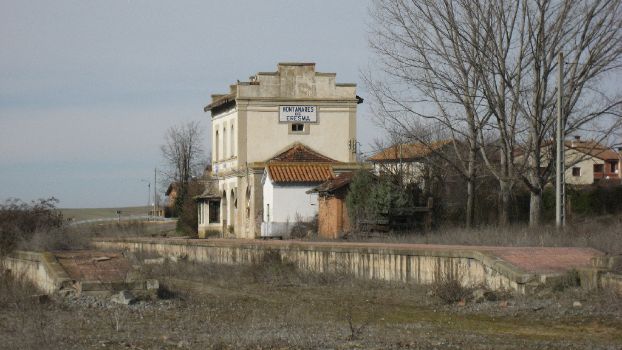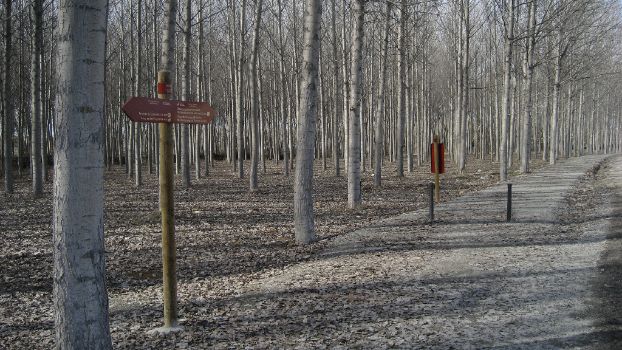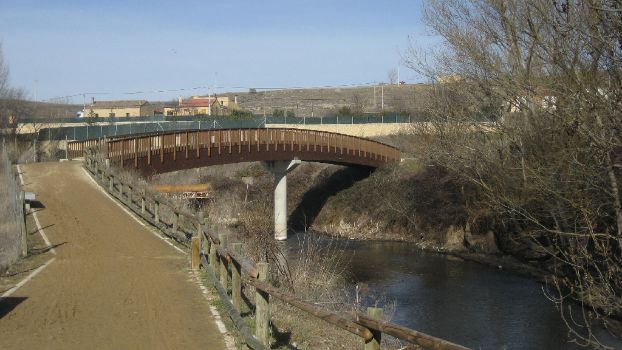Net of Natural
Trails

River Eresma Nature Trail
Description
From the foothills of Guadarrama to the fields of cereal crops
The Nature Trail runs through several landscapes that create transition zones from the foothills of Sierra de Guadarrama to the fields of cereal in the Douro basin. The eight kilometre route crosses through different zones, including riparian vegetation, reforestation and a protected holm oak grove. The route starts in the city of Segovia, descends to the floor of Eresma River Valley, and continues to the vast floodplains where Hontanares de Eresma is located.
Eresma Nature Trail starts at the confluence of the rivers Eresma and Clamores, where the city of Segovia sits on limestone slabs (flat top hills) at the foot of Sierra de Guadarrama. The route starts in Altos de la Piedad, an excellent vantage point overlooking Segovia and its main monuments like the Alcázar, the Cathedral and the Aqueduct. The old quarter of Segovia and its aqueduct were designated a UNESCO World Heritage Site in 1985.

In Altos de la Piedad, in a rest area opposite Segovia's hospital complex, is a stone cross and information panels on the route. After enjoying the views, the route crosses La Piedad Street at the pedestrian crossing and reaches a clearing used as a car park. The Trail skirts around the motocross circuit along a clearly marked gravel path that leads to the riverbank.
Leaving the circuit behind, a protection fence runs along a steep embankment to the right of the path that is increasingly populated by conifers, primarily Arizona cypresses (Cupressus arizonica) and pines (Pinus pinea). An opening in the fence allows the route to descend through the trees to Mirador del Último Pino, with interesting views of the ravine and the city of Segovia on one side, and on the other, the Cathedral and the Alcázar, constant companions throughout the journey.
Back on the Trail, the route arrives at Mirador del Alcázar, with sweeping views of Eresma and Clamores valleys, the historic city centre of Segovia and the area of Zamarramala and Las Lastrillas. The Sanctuary of Fuencisla and the monasteries of El Parral and San Vicente are located in Eresma Valley.

There are also other interesting views from the Mirador del Alcázar, including the districts of San Lorenzo and San Marcos, and the road leading to the church of Vera Cruz, a 13th century Romanesque temple declared National Monument in 1919, and whose origin is shrouded in mystery. The temple has what appears to be a circular (dodecagonal) layout. Although its construction was originally attributed to the Templars, it has subsequently been linked to the Knights of the Holy Sepulchre.
From Mirador del Alcázar, the route continues down a steep stone staircase. There is an alternative route via a gentler slope next to an area of reforestation pines. The whole area is protected under the Special Landscape Protection Programme for Clamores-Pinarillo Valley, which prohibits building. Before going down another flight of (less steep) masonry stairs leading to Eresma, an information panel explains the views that can be seen from this point.
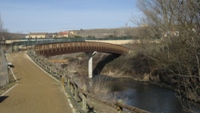
There is another sign next to the San Lázaro Bridge, near the River Eresma, indicating the distances to various points of interest. There is a large rest area in the nearby shrine of Nuestra Señora de Fuencisla, and across the bridge, is the Arco de San Lázaro or Fuencisla, which served as a gate to the city.
Without crossing the river, the road runs along the left bank, where various bird species nest on the cliffs to the left, and a typical gallery forest can be found on the right: poplar (Populus sp.), brambles (Rubus ulmifolius) and a few willows (Salix sp.). The stone benches along the path are an invitation to sit and listen to the sounds of the river.

After crossing the River Eresma by a footbridge, extreme caution should be taken as this part of the route runs parallel to the road where vehicles pass. On arriving at La Pilarcita rest area, next to the namesake chapel, the route crosses the road, past an industrial estate, and turns onto a country road.
From here, the road passes through pastures and farmlands, with flocks of birds flying overhead every now and then, including starlings (Sturnus unicolor) or vultures (Gyps fulvus) and an occasional kite (Milvus milvus). It passes close to a livestock farm and a riding school, opposite which is the Zorroclin rest area. The agricultural landscape is interrupted by a small pine stand and several poplar groves that grow in places close to the river Eresma or on a rocky outcrop.

The Nature Trail continues again from this point, running for a kilometer parallel to the Valle del Eresma Greenway Nature Trail (which uses the old Medina del Campo-Segovia railway platform . Some of its milestones can still be seen), and crossing the bridge over Valdelobones Brook.
Poplars will be a constant companion as the Trail heads towards the river. A cliff to the right is home to crows (Corvus corax). Near the village of Hontanares de Eresma, the route crosses the SG-V-3122 at a pedestrian crossing near a horseshoeing stand. The village can be easily accessed from here.

The Hontanares Park rest area is located across the road. Further on, the route skirts around a sports centre and continues through fields of crops to the Hontanares station rest area. Here ends the Trail, at the information panel on the old railway line. From here, the Valle del Eresma Greenway Nature Trail can be reached once again. This trail continues along the old railway until Nava de la Asunción.
Although the Nature Trail ends at the rest area, just a few metres away are the remains of the old railway station, of which only the railway stop still stands, and hidden in the vegetation is the changeover point.
Profile
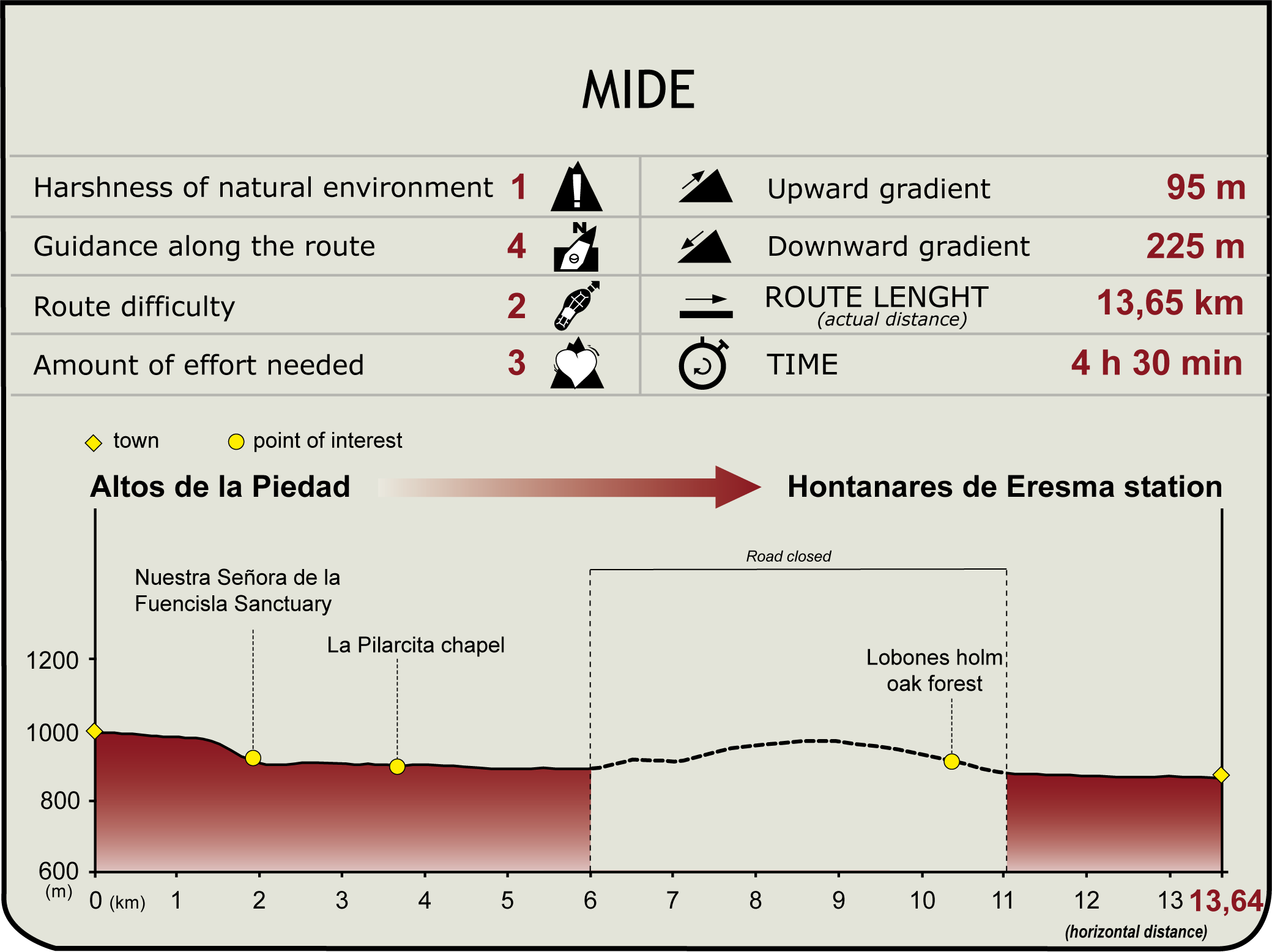
Highlights
Further information
Segovia
Visigoths and Muslims also left their mark in Segovia, although their footprint is not on the same scale as the Roman aqueduct. Some of the zoomorphic sculptures found in the city prove that its history has Celtiberian roots. While the Aqueduct attests to its place in the Roman Empire, the Visigoth necropolis confirms the existence of a Germanic settlement. Historians argue that Segovia was abandoned after the Islamic invasion and repopulated in the late eleventh century by Christians from the north and the Pyrenees.
The late Middle Ages was one of the most glorious periods in the city: colonisation of a vast territory, expansion of the community to both sides of the mountains; a large Jewish population living in the Jewish quarter; the court residence of the Trastámara kings; and, a legacy of Gothic art evident in monasteries and convents. It also had a large textile industry and large herds of sheep. Queen Isabella the Catholic was crowned in 1474 in the church of San Miguel, near the Plaza Mayor. The Segovian “comunero” Juan Bravo was beheaded in Villamar, and the Alcázar became the most important fortress in Castile.
The Alcázar
Located on a prow-shaped rock at the confluence of the rivers Eresma and Clamores, the Alcázar of Segovia was an impregnable fortress during centuries. Although the oldest document that makes reference to the Alcázar dates back to 1122, shortly after King Alphonse VI reconquered the city, it was originally a Celtiberian fortified settlement. Given its strategic location, both the Romans and Arabs used it as a fortress.
In its heyday, during the Middle Ages, the Alcázar was the favourite residence of the kings of Castile. King Alphonse X the Wise considered the Alcázar his favourite residence, and held Court here in 1256. Until its destruction by fire in 1862, the houses of Burgundy, Trastámara, Austria and Bourbon left their mark on the building through several renovations, adding architectural elements to suit their preferences and the style in vogue at the time.
There are many legends about the history of Segovia's Alcázar. One refers to the tragedy of the infant Prince Don Pedro, one of many illegitimate children of King Henry II. Legend has it that one day in 1366 the prince was playing in one of the balconies of the Alcázar and fell off the cliff. His nanny, fearful of the punishment, threw herself after him. Another version claims that the nursemaid stood in the balcony of the Hall of Kings, with the baby in her arms, and that after the infant fell into the void, the desperate nanny also threw herself.
Segovia-Medina del Campo railway line
Hontanares-Eresma station was part of the Segovia-Medina del Campo (Valladolid) railway line. Opened in 1884, this line remained in operation until 1993, when it was closed due to lack of profit. It is now being converted into a Greenway for rural tourism and sports activities.
The concession of the railway line was awarded on August 11, 1881 to Miguel Muruve, a Member of the Segovian Parliament, who later sold it to the Compañía del Norte. The railway was opened to service on June 1, 1884. The line had various stops and sidings starting from Segovia: Hontanares de Eresma (KM 13.21), Ahusín, Yanguas de Eresma-Carbonero el Mayor, Armuña-Bernardos, Ortigosa de Pestaño-Santa María de Nieva, Nava de la Asunción, Coca, Ciruelos de Coca, Fuente de Santa Cruz, Fuente Olmedo, Olmedo de Adaja, Pozal de Gallinas and Medina del Campo.



